Statistical Evaluation of NO2 Emissions in Mashhad City Using Cisco Network Model
Abstract
1. Introduction
- Materials: Several studies focus on the development and characterization of novel materials for gas sensors, such as SnO2 nanowires, CuS quantum dots, Bi2S3 nanosheets, and carbon nanotubes. These materials play a crucial role in enhancing the sensitivity and selectivity of gas sensors.
- Modeling: Some papers employ mathematical models, neural networks, and simulation techniques to understand sensor behavior, predict gas concentrations, and optimize sensor performance. These models provide insights into the underlying mechanisms of gas sensing and help improve sensor design.
- Characterization: Characterization techniques like scanning electron microscopy (SEM), X-ray diffraction (XRD), and density functional calculation are utilized to analyze the morphology, structure, and properties of gas sensing materials and devices. This characterization is essential for understanding the structure–property relationships and optimizing sensor performance.
- Control: Control strategies are explored to enhance the sensitivity, stability, and response time of gas sensors. This includes optimizing electrode materials, surface-to-volume ratios, and charge transfer pathways to improve gas adsorption and charge transportation efficiency.
- Managerial: While most studies focus on technical aspects of gas sensing technology, there is a lack of emphasis on managerial insights, such as the implementation of sensor networks in real-world environments, policy interventions to address air pollution, and decision-making processes for deploying sensor systems.
- Macroscopic Scale: Some studies address broader environmental issues related to air pollution, transportation emissions, and public health concerns. They discuss the impact of sensor technology on urban environments, the effectiveness of ventilation systems in mitigating air pollution, and the need for regulatory measures to reduce emissions.
Bibliometrics Overview
2. Materials and Methods
- Statistical Evaluation of NO2 Pollution Emission: This step involves conducting a thorough statistical evaluation of NO2 pollution emissions, focusing on a specific case study, namely Mashhad City in Iran. Various statistical analyses are performed to assess the extent and distribution of NO2 pollution in the city, providing valuable insights into the spatial and temporal patterns of air pollution.
- Determination of Thresholds: After the statistical evaluation, thresholds for NO2 pollution are determined based on the observed pollution levels and environmental standards.
- Conceptual Modeling of Sensor Network Operation: The final step involves developing a conceptual model for the operation of a sensor network on a large scale. This model utilizes the Cisco Network Model framework to design and optimize the deployment of the sensor network across the megacity environment. Considerations such as sensor placement, data transmission, network architecture, and data analysis are incorporated into the conceptual model to ensure efficient and effective operation of the sensor network.
3. NO2 Sensor Application in Mashhad, Iran, as a Megacity
4. Managerial Insights
5. Conclusions
Author Contributions
Funding
Data Availability Statement
Conflicts of Interest
References
- Maleki, A.A.; Tanjah, F.; Vaezi, G. Relationship between Air Pollutants and Mortality from Cardiorespiratory Diseases in Mashhad: A Step Towards Increasing Citizens’ Awareness of Adverse Effects of Pollutants. J. Environ. Educ. Sustain. Dev. 2019, 7, 117–126. [Google Scholar] [CrossRef]
- Hatami, M.; Mohammadi, M.M.; Esmaeli, R.; Mohammadi, M. Assessing the Relationship Between Meteorological Parameters, Air Pollution and Cardiovascular Mortality of Mashhad City Based on Time Series Model. Iran. J. Health Saf. Environ. 2017, 5, 894–903. [Google Scholar]
- Afif, C.; Dutot, A.L.; Jambert, C.; Abboud, M.; Adjizian-Gérard, J.; Farah, W.; Perros, P.E.; Rizk, T. Statistical Approach for the Characterization of NO2 Concentrations in Beirut. Air Qual. Atmos. Health 2009, 2, 57–67. [Google Scholar] [CrossRef]
- Dmitrzak, M.; Jasinski, P.; Jasinski, G. Limited Selectivity of Amperometric Gas Sensors Operating in Multicomponent Gas Mixtures and Methods of Selectivity Improvement. Bull. Pol. Acad. Sci. Tech. Sci. 2020, 68, 1275–1282. [Google Scholar] [CrossRef]
- Awan, F.M.; Minerva, R.; Crespi, N. Improving Road Traffic Forecasting Using Air Pollution and Atmospheric Data: Experiments Based on LSTM Recurrent Neural Networks. Sensors 2020, 20, 3749. [Google Scholar] [CrossRef] [PubMed]
- Masey, N.; Gillespie, J.; Ezani, E.; Lin, C.; Wu, H.; Ferguson, N.S.; Hamilton, S.; Heal, M.R.; Beverland, I.J. Temporal Changes in Field Calibration Relationships for Aeroqual S500 O3 and NO2 Sensor-Based Monitors. Sens. Actuators B Chem. 2018, 273, 1800–1806. [Google Scholar] [CrossRef]
- Lai, W.-I.; Chen, Y.-Y.; Sun, J.-H. Ensemble Machine Learning Model for Accurate Air Pollution Detection Using Commercial Gas Sensors. Sensors 2022, 22, 4393. [Google Scholar] [CrossRef]
- Di Renzone, G.; Landi, E.; Mugnaini, M.; Parri, L.; Peruzzi, G.; Pozzebon, A. Assessment of LoRaWAN Transmission Systems Under Temperature and Humidity, Gas, and Vibration Aging Effects Within IIoT Contexts. IEEE Trans. Instrum. Meas. 2022, 71, 1–11. [Google Scholar] [CrossRef]
- Aroud, R.A.; Blasi, A.H.; Alsuwaiket, M. Intelligent Risk Alarm for Asthma Patients Using Artificial Neural Networks. Int. J. Adv. Comput. Sci. Appl. 2020, 11, 95–100. [Google Scholar] [CrossRef]
- Mawrence, R.; Munniks, S.; Valente, J. Calibration of Electrochemical Sensors for Nitrogen Dioxide Gas Detection Using Unmanned Aerial Vehicles. Sensors 2020, 20, 7332. [Google Scholar] [CrossRef]
- Zuidema, C.; Schumacher, C.S.; Austin, E.; Carvlin, G.; Larson, T.V.; Spalt, E.W.; Zusman, M.; Gassett, A.J.; Seto, E.; Kaufman, J.D.; et al. Deployment, Calibration, and Cross-Validation of Low-Cost Electrochemical Sensors for Carbon Monoxide, Nitrogen Oxides, and Ozone for an Epidemiological Study. Sensors 2021, 21, 4214. [Google Scholar] [CrossRef] [PubMed]
- Panzardi, E.; Lo Grasso, A.; Vignoli, V.; Mugnaini, M.; Lupetti, P.; Fort, A. NO2 Sensing with SWCNT Decorated by Nanoparticles in Temperature Pulsed Mode: Modeling and Characterization. Sensors 2020, 20, 4729. [Google Scholar] [CrossRef] [PubMed]
- Arroyo, P.; Gómez-Suárez, J.; Suárez, J.I.; Lozano, J. Low-Cost Air Quality Measurement System Based on Electrochemical and PM Sensors with Cloud Connection. Sensors 2021, 21, 6228. [Google Scholar] [CrossRef] [PubMed]
- Vajs, I.; Drajic, D.; Cica, Z. COVID-19 Lockdown in Belgrade: Impact on Air Pollution and Evaluation of a Neural Network Model for the Correction of Low-Cost Sensors’ Measurements. Appl. Sci. 2021, 11, 10563. [Google Scholar] [CrossRef]
- Mohd Nadzir, M.S.; Mohd Nor, M.Z.; Mohd Nor, M.F.F.; A Wahab, M.I.; Ali, S.H.M.; Otuyo, M.K.; Abu Bakar, M.A.; Saw, L.H.; Majumdar, S.; Ooi, M.C.G.; et al. Risk Assessment and Air Quality Study during Different Phases of COVID-19 Lockdown in an Urban Area of Klang Valley, Malaysia. Sustainability 2021, 13, 12217. [Google Scholar] [CrossRef]
- Han, P.; Mei, H.; Liu, D.; Zeng, N.; Tang, X.; Wang, Y.; Pan, Y. Calibrations of Low-Cost Air Pollution Monitoring Sensors for CO, NO2, O3, and SO2. Sensors 2021, 21, 256. [Google Scholar] [CrossRef]
- Pedowitz, M.D.; Kim, S.; Lewis, D.I.; Uppalapati, B.; Khan, D.; Bayram, F.; Koley, G.; Daniels, K.M. Fast Selective Sensing of Nitrogen-Based Gases Utilizing δ-MnO2-Epitaxial Graphene-Silicon Carbide Heterostructures for Room Temperature Gas Sensing. J. Microelectromechanical Syst. 2020, 29, 846–852. [Google Scholar] [CrossRef]
- Samad, A.; Kieser, J.; Chourdakis, I.; Vogt, U. Developing a Cloud-Based Air Quality Monitoring Platform Using Low-Cost Sensors. Sensors 2024, 24, 945. [Google Scholar] [CrossRef]
- Gómez-Suárez, J.; Arroyo, P.; Alfonso, R.; Suárez, J.I.; Pinilla-Gil, E.; Lozano, J. A Novel Bike-Mounted Sensing Device with Cloud Connectivity for Dynamic Air-Quality Monitoring by Urban Cyclists. Sensors 2022, 22, 1272. [Google Scholar] [CrossRef]
- Laref, R.; Losson, E.; Sava, A.; Siadat, M. Empiric Unsupervised Drifts Correction Method of Electrochemical Sensors for in Field Nitrogen Dioxide Monitoring. Sensors 2021, 21, 3581. [Google Scholar] [CrossRef]
- González, E.; Casanova-Chafer, J.; Romero, A.; Vilanova, X.; Mitrovics, J.; Llobet, E. LoRa Sensor Network Development for Air Quality Monitoring or Detecting Gas Leakage Events. Sensors 2020, 20, 6225. [Google Scholar] [CrossRef] [PubMed]
- Dautzenberg, E.; Claassen, F.W.; de Smet, L.C.P.M. Functionalized Modulators in Imine-Linked Covalent Organic Frameworks (COFs). Microporous Mesoporous Mater. 2023, 350, 112318. [Google Scholar] [CrossRef]
- Pfister, V.; Prato, M.; Penza, M. Field Performance Evaluation of Air Quality Low-Cost Sensors Deployed in a Near-City Space-Airport. Eng. Proc. 2023, 48, 27. [Google Scholar] [CrossRef]
- Mumtaz, R.; Zaidi, S.M.H.; Shakir, M.Z.; Shafi, U.; Malik, M.M.; Haque, A.; Mumtaz, S.; Zaidi, S.A.R. Internet of Things (IoT) Based Indoor Air Quality Sensing and Predictive Analytic—A COVID-19 Perspective. Electronics 2021, 10, 184. [Google Scholar] [CrossRef]
- Saravana Ram, R.; Venkatachalam, K.; Masud, M.; Abouhawwash, M. Air Pollution Prediction Using Dual Graph Convolution LSTM Technique. Intell. Autom. Soft Comput. 2022, 33, 1639–1652. [Google Scholar] [CrossRef]
- Alhasa, K.; Mohd Nadzir, M.; Olalekan, P.; Latif, M.; Yusup, Y.; Iqbal Faruque, M.; Ahamad, F.; Abd. Hamid, H.; Aiyub, K.; Md Ali, S.; et al. Calibration Model of a Low-Cost Air Quality Sensor Using an Adaptive Neuro-Fuzzy Inference System. Sensors 2018, 18, 4380. [Google Scholar] [CrossRef]
- Loganathan, V.; Ravikumar, D.; Devaraj, V.; Kannan, U.M.; Kesavan, R. Development of a Compact IoT-Enabled Device to Monitor Air Pollution for Environmental Sustainability. Eng. Proc. 2023, 58, 18. [Google Scholar] [CrossRef]
- Manikandan, S.; Arun Francis, G.; Mithya, V.; Kamal, C.; Dhilip Kumar, S.; Harriprasath, R.; Sankar, P. A Smart Helmet for Air Quality and Hazardous Event Detection for the Mining Industry. Int. J. Innov. Technol. Explor. Eng. 2019, 8, 1447–1449. [Google Scholar] [CrossRef]
- Suriano, D.; Cassano, G.; Penza, M. Design and Development of a Flexible, Plug-and-Play, Cost-Effective Tool for on-Field Evaluation of Gas Sensors. J. Sens. 2020, 2020, 8812025. [Google Scholar] [CrossRef]
- Si Tayeb, M.; Anis Benallal, M.; Salim Benabadji, M.; Houari, A. IoT Monitoring System for Air Quality Assessment and Collecting Data. Indones. J. Electr. Eng. Comput. Sci. 2022, 28, 1592. [Google Scholar] [CrossRef]
- Duangsuwan, S.; Prapruetdee, P.; Subongkod, M.; Klubsuwan, K. 3D AQI Mapping Data Assessment of Low-Altitude Drone Real-Time Air Pollution Monitoring. Drones 2022, 6, 191. [Google Scholar] [CrossRef]
- Bizak, Z.; Faleiros, M.C.; Vijjapu, M.T.; Yaqoob, U.; Salama, K.N. Highly Sensitive Wireless NO2 Gas Sensing System. IEEE Sens. J. 2023, 23, 15667–15674. [Google Scholar] [CrossRef]
- Kałużyński, P.; Mucha, W.; Capizzi, G.; Lo Sciuto, G. Chemiresistor Gas Sensors Based on Conductive Copolymer and ZnO Blend—Prototype Fabrication, Experimental Testing, and Response Prediction by Artificial Neural Networks. J. Mater. Sci. Mater. Electron. 2022, 33, 26368–26382. [Google Scholar] [CrossRef]
- Jin, H.; Yu, J.; Cui, D.; Gao, S.; Yang, H.; Zhang, X.; Hua, C.; Cui, S.; Xue, C.; Zhang, Y.; et al. Remote Tracking Gas Molecular via the Standalone-Like Nanosensor-Based Tele-Monitoring System. Nano-Micro Lett. 2021, 13, 1–14. [Google Scholar] [CrossRef]
- Fort, A.; Panzardi, E.; Al-Hamry, A.; Vignoli, V.; Mugnaini, M.; Addabbo, T.; Kanoun, O. Highly Sensitive Detection of NO2 by Au and TiO2 Nanoparticles Decorated SWCNTs Sensors. Sensors 2019, 20, 12. [Google Scholar] [CrossRef]
- Drozdowska, K.; Rehman, A.; Krajewska, A.; Lioubtchenko, D.V.; Pavłov, K.; Rumyantsev, S.; Smulko, J.; Cywiński, G. Effects of UV Light Irradiation on Fluctuation Enhanced Gas Sensing by Carbon Nanotube Networks. Sens. Actuators B Chem. 2022, 352, 131069. [Google Scholar] [CrossRef]
- Tancev, G.; Toro, F.G. Stochastic Online Calibration of Low-Cost Gas Sensor Networks with Mobile References. IEEE Access 2022, 10, 13901–13910. [Google Scholar] [CrossRef]
- Kim, Y.; Bak, S.-Y.; Lee, J.; Lee, S.-H.; Woo, K.; Lee, S.; Yi, M. Highly Sensitive and Selective NO2 Gas Sensor at Low Temperature Based on SnO2 Nanowire Network. J. Sens. Sci. Technol. 2021, 30, 175–180. [Google Scholar] [CrossRef]
- Chen, X.; Wang, T.; Shi, J.; Lv, W.; Han, Y.; Zeng, M.; Yang, J.; Hu, N.; Su, Y.; Wei, H.; et al. A Novel Artificial Neuron-Like Gas Sensor Constructed from CuS Quantum Dots/Bi2S3 Nanosheets. Nano-Micro Lett. 2022, 14, 8. [Google Scholar] [CrossRef]
- Thornes, J.E.; Hickman, A.; Baker, C.; Cai, X.; Delgado-Saborit, J.M.; Quaiyoom, A. Proposed Interventions to Reduce Noxious Air Pollution at Birmingham New Street Station. Proc. Inst. Civ. Eng.—Transp. 2022, 175, 387–392. [Google Scholar] [CrossRef]
- Ly, H.-B.; Le, L.M.; Phi, L.V.; Phan, V.-H.; Tran, V.Q.; Pham, B.T.; Le, T.-T.; Derrible, S. Development of an AI Model to Measure Traffic Air Pollution from Multisensor and Weather Data. Sensors 2019, 19, 4941. [Google Scholar] [CrossRef] [PubMed]
- Shen, Y.; Jiang, F.; Feng, S.; Zheng, Y.; Cai, Z.; Lyu, X. Impact of weather and emission changes on NO2 concentrations in China during 2014–2019. Environ. Pollut. 2021, 269, 116163. [Google Scholar] [CrossRef]
- Gheibi, M.; Taghavian, H.; Moezzi, R.; Waclawek, S.; Cyrus, J.; Dawiec-Lisniewska, A.; Koci, J.; Khaleghiabbasabadi, M. Design of a Decision Support System to Operate a NO2 Gas Sensor Using Machine Learning, Sensitive Analysis and Conceptual Control Process Modelling. Chemosensors 2023, 11, 126. [Google Scholar] [CrossRef]
- Nemati, F.; Mahvi, A.; Mohseni, S.M. Health Impacts of NO2 in Mashhad, Iran. J. Air Pollut. Health 2016, 1, 15–20. [Google Scholar]
- Park, J.; Kim, Y.; Park, S.Y.; Sung, S.J.; Jang, H.W.; Park, C.R. Band Gap Engineering of Graphene Oxide for Ultrasensitive NO2 Gas Sensing. Carbon 2020, 159, 175–184. [Google Scholar] [CrossRef]
- Mashhad Air Quality Index (AQI) and Iran Air Pollution IQAir. 2024. Available online: https://www.iqair.com/iran/razavi-khorasan/mashhad (accessed on 1 June 2024).
- Huang, D.; Li, Q.; Li, G.; Wang, X.; Sun, L. Tougher targets for China’s clean air cities? Implications from air quality assessment in Shenzhen. Preprints 2018, 2018100101. [Google Scholar] [CrossRef]
- Hesterberg, T.W.; Bunn, W.B.; McClellan, R.O.; Hamade, A.K.; Long, C.M.; Valberg, P.A. Critical review of the human data on short-term nitrogen dioxide (NO2) exposures: Evidence for NO2 no-effect levels. Crit. Rev. Toxicol. 2009, 39, 743–781. [Google Scholar] [CrossRef]
- Stieb, D.M.; Judek, S.; Burnett, R.T. Meta-analysis of time-series studies of air pollution and mortality: Effects of gases and particles and the influence of cause of death, age, and season. J. Air Waste Manag. Assoc. 2002, 52, 470–484. [Google Scholar] [CrossRef]
- Copernicus Sentinel-5P Mapping Portal. Available online: https://maps.s5p-pal.com/no2-tropospheric/ (accessed on 8 August 2024).
- India: NO₂ Concentration by City. Statista. Available online: https://www.statista.com/statistics/1284361/india-concentration-of-nitrogen-dioxide-by-city/ (accessed on 1 June 2024).
- Live Animated Air Quality Map (AQI, PM 2.5...). IQAir. Available online: https://www.iqair.com/air-quality-map (accessed on 10 August 2024).
- Tudoroiu, E.-R.; Neacsu, G.; Astilean, A.; Zoltan, M.; Letia, T.; Tudoroiu, N. Fuzzy UML and Petri nets modeling investigations on the pollution impact on the air quality in the vicinity of the Black Sea Constanta Romanian resort. In Proceedings of the 2011 Federated Conference on Computer Science and Information Systems (FedCSIS), Szczecin, Poland, 18–21 September 2011; 2011; pp. 763–766. [Google Scholar]
- Gharibvand, L.K.; Jamali, A.A.; Amiri, F. Changes in NO2 and O3 levels due to the pandemic lockdown in the industrial cities of Tehran and Arak, Iran using Sentinel 5P images, Google Earth Engine (GEE) and statistical analysis. Stoch. Environ. Res. Risk Assess. 2023, 37, 2023–2034. [Google Scholar] [CrossRef]
- Ghozikali, M.G.; Mosaferi, M.; Safari, G.H.; Jaafari, J. Effect of exposure to O3, NO2, and SO2 on chronic obstructive pulmonary disease hospitalizations in Tabriz, Iran. Environ. Sci. Pollut. Res. 2015, 22, 2817–2823. [Google Scholar] [CrossRef]
- Azimi, F.; Hafezi, F.; Ghaderpoori, M.; Kamarehie, B.; Karami, M.A.; Sorooshian, A.; Baghani, A.N. Temporal characteristics and health effects related to NO2, O3, and SO2 in an urban area of Iran. Environ. Pollut. 2024, 349, 123975. [Google Scholar] [CrossRef] [PubMed]
- Karimi, A.; Shirmardi, M.; Hadei, M.; Birgani, Y.T.; Neisi, A.; Takdastan, A.; Goudarzi, G. Concentrations and health effects of short-and long-term exposure to PM 2.5, NO2, and O3 in ambient air of Ahvaz city, Iran (2014–2017). Ecotoxicol. Environ. Saf. 2019, 180, 542–548. [Google Scholar] [CrossRef] [PubMed]
- Alnaim, A.; Sun, Z.; Tong, D. Evaluating machine learning and remote sensing in monitoring NO2 emission of power plants. Remote Sens. 2022, 14, 729. [Google Scholar] [CrossRef]
- Bhraguram, T.M.; Rajesh, R.K.; Mohanan, S.; Tabassum, M. A novel approach to indoor air quality monitoring by Cisco IoT-based toxic measurement system. In Next Generation Communication Networks for Industrial Internet of Things Systems; Perumal, S., Tabassum, M., Sharma, M., Mohanan, S., Eds.; CRC Press: Boca Raton, FL, USA, 2023. [Google Scholar]
- Lewis, A.; Peltier, W.R.; von Schneidemesser, E. Low-Cost Sensors for the Measurement of Atmospheric Composition: Overview of Topic and Future Applications; World Meteorological Organization (WMO): Geneva, Switzerland, 2018. [Google Scholar]
- World Meteorological Organization (WMO). An Update on Low-Cost Sensors for the Measurement of Atmospheric Composition. Available online: https://library.wmo.int/records/item/37465-an-update-on-low-cost-sensors-for-the-measurement-of-atmospheric-composition. (accessed on 8 August 2024).
- Sofia, D.; Giuliano, A.; Gioiella, F.; Barletta, D.; Poletto, M. Modeling of an Air Quality Monitoring Network with High Space-Time Resolution. In Computer Aided Chemical Engineering; Friedl, A., Klemeš, J.J., Radl, S., Varbanov, P.S., Wallek, T., Eds.; Elsevier: Amsterdam, The Netherlands, 2018; Volume 43, pp. 193–198. ISBN 9780444642356. [Google Scholar]
- Borrego, C.; Ginja, J.; Coutinho, M.; Ribeiro, C.; Karatzas, K.; Sioumis, T.; Katsifarakis, N.; Konstantinidis, K.; De Vito, S.; Esposito, E.; et al. Assessment of Air Quality Microsensors versus Reference Methods: The EuNetAir Joint Exercise—Part II. Atmos. Environ. 2018, 193, 127–142. [Google Scholar] [CrossRef]
- Williams, R.; Duvall, R.; Kilaru, V.; Hagler, G.; Hassinger, L.; Benedict, K.; Rice, J.; Kaufman, A.; Judge, R.; Pierce, G.; et al. Deliberating Performance Targets Workshop: Potential Paths for Emerging PM 2.5 and O3 Air Sensor Progress. Atmos. Environ. X 2019, 2, 100031. [Google Scholar] [CrossRef]
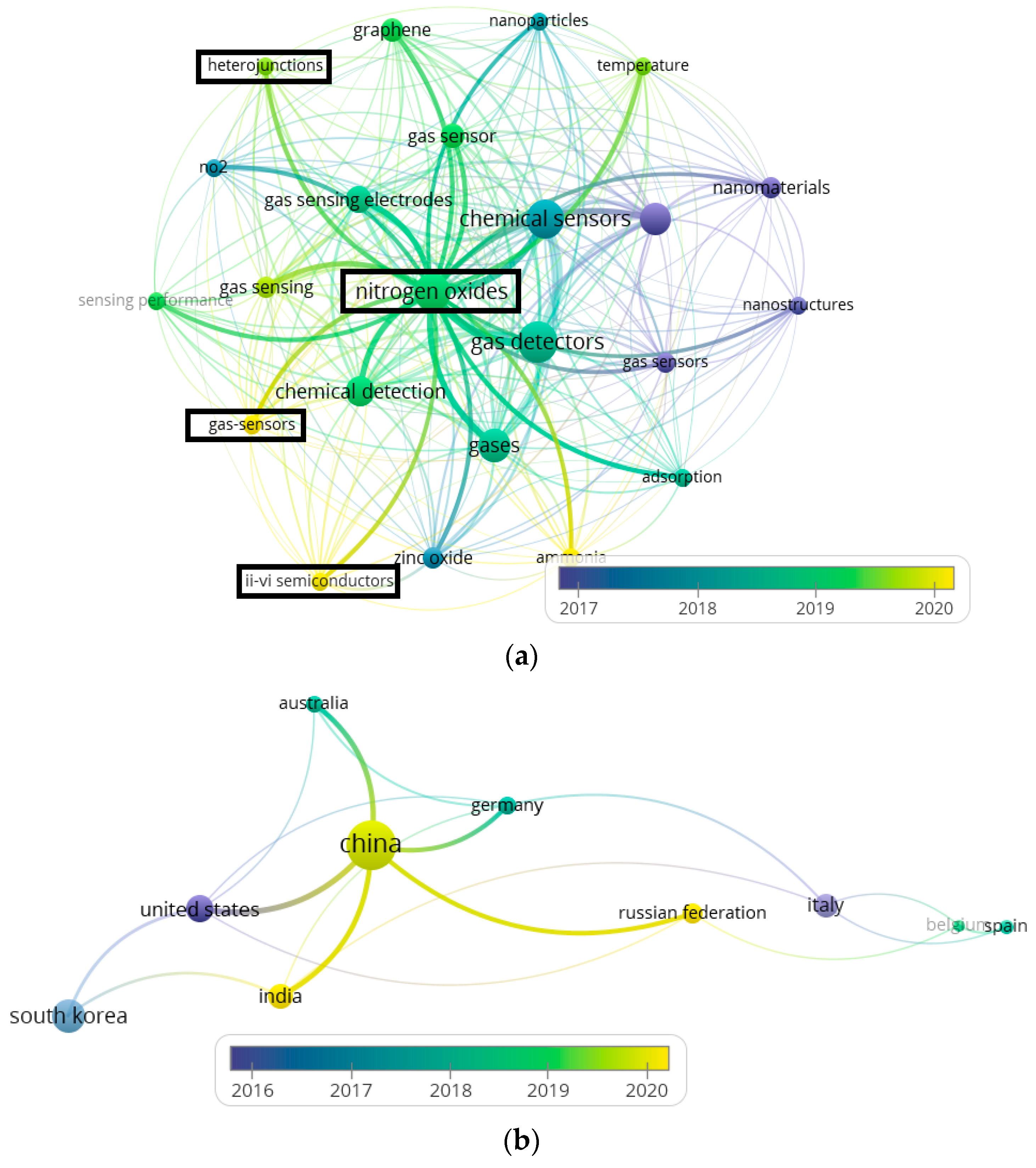
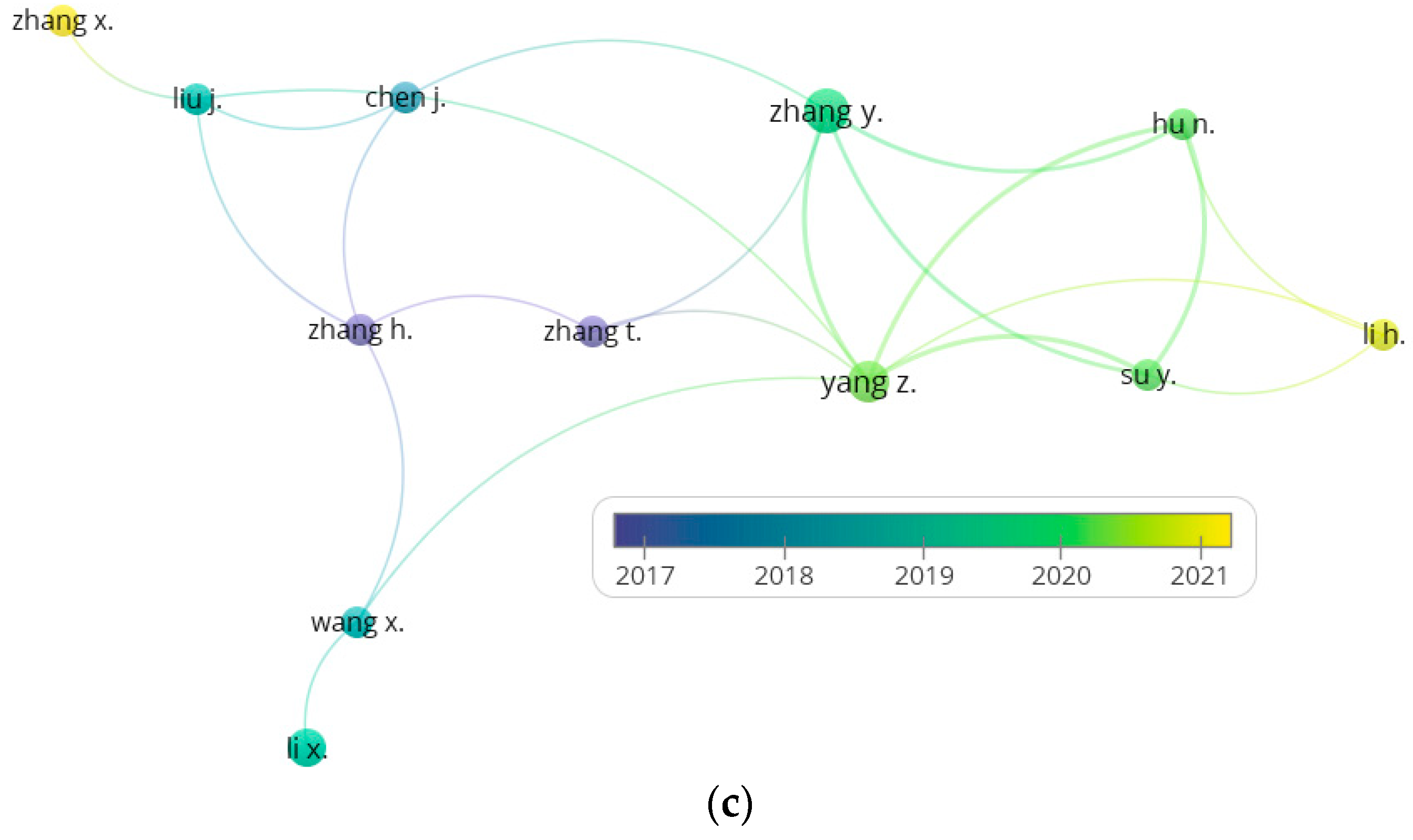

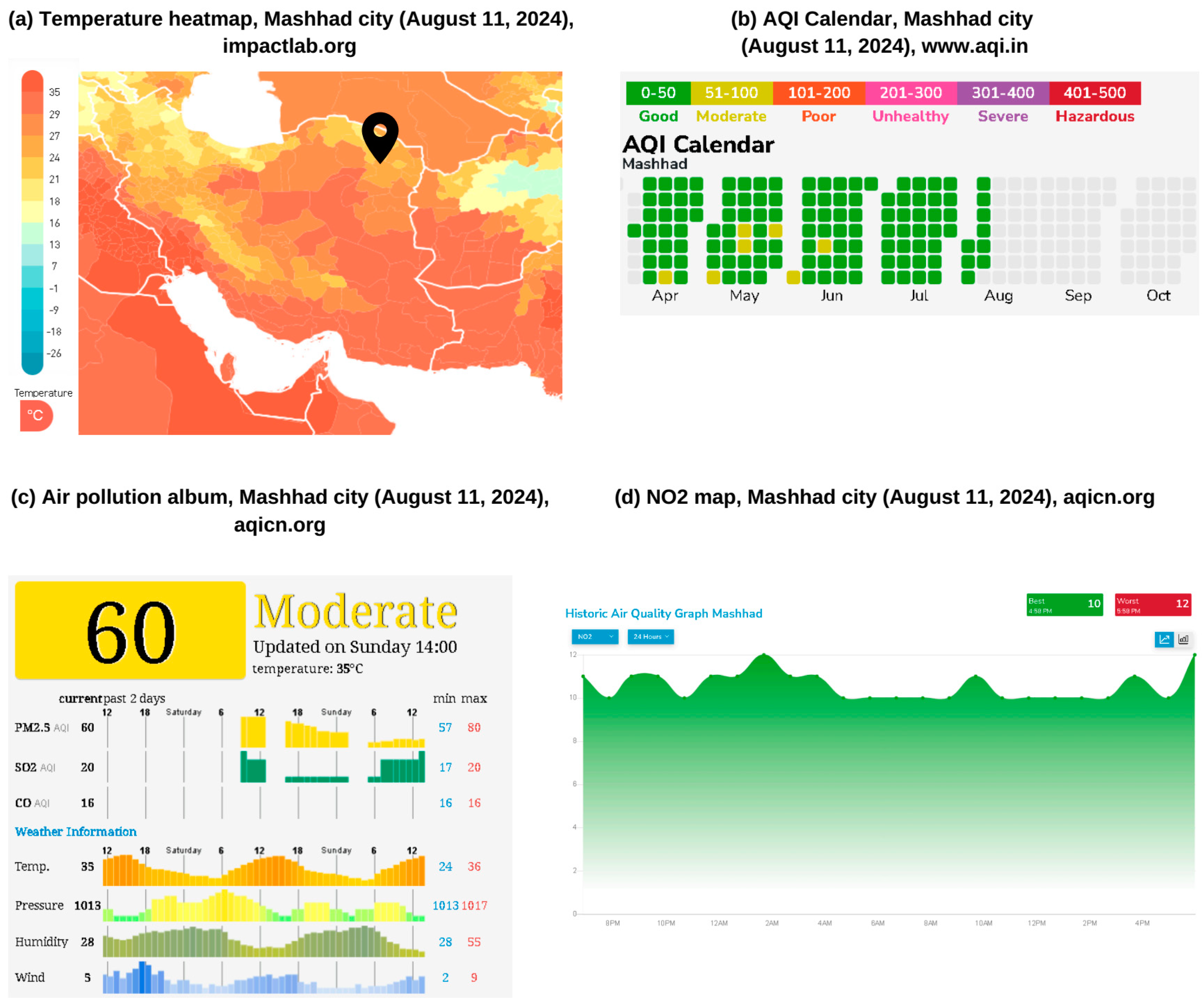
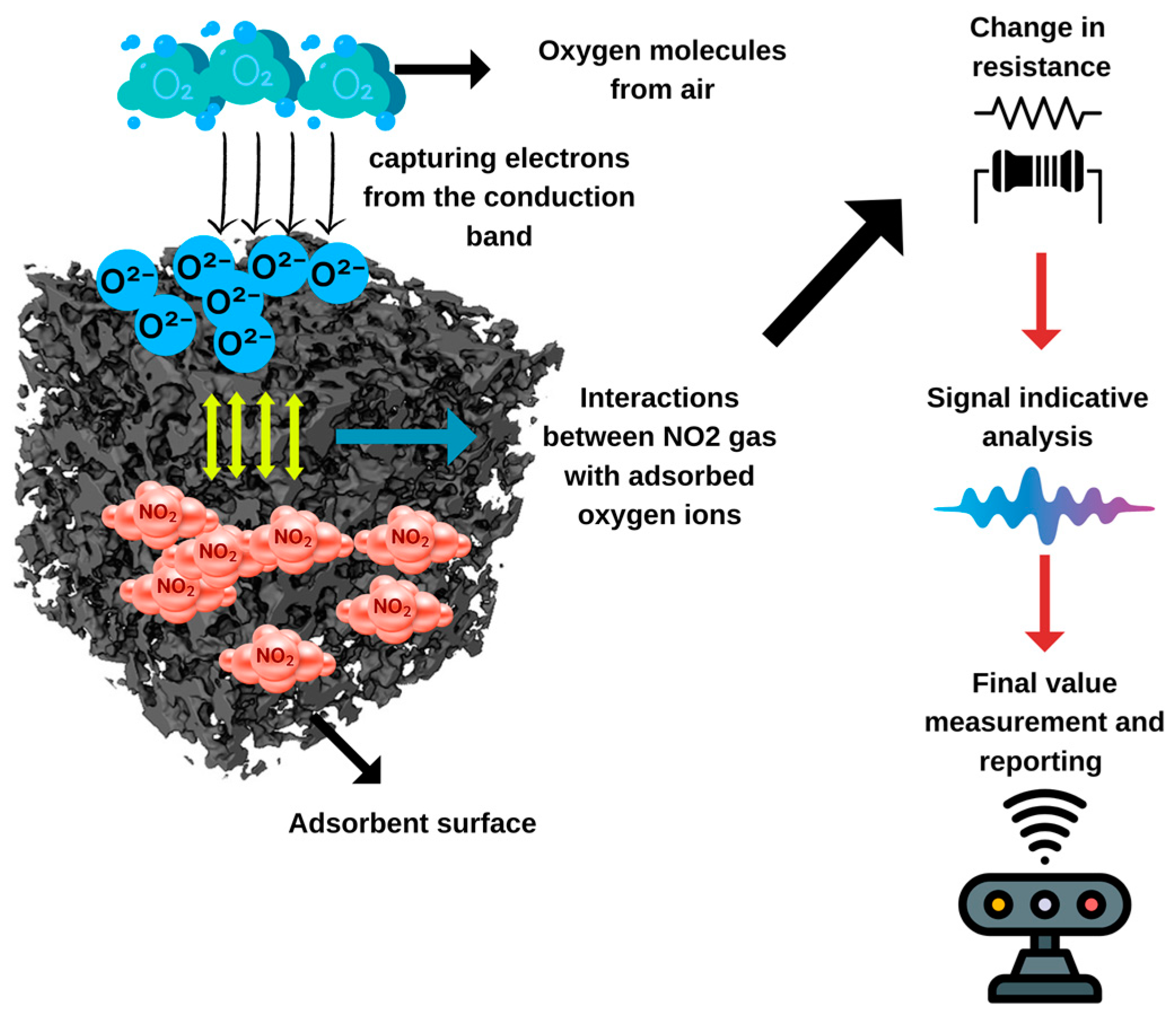
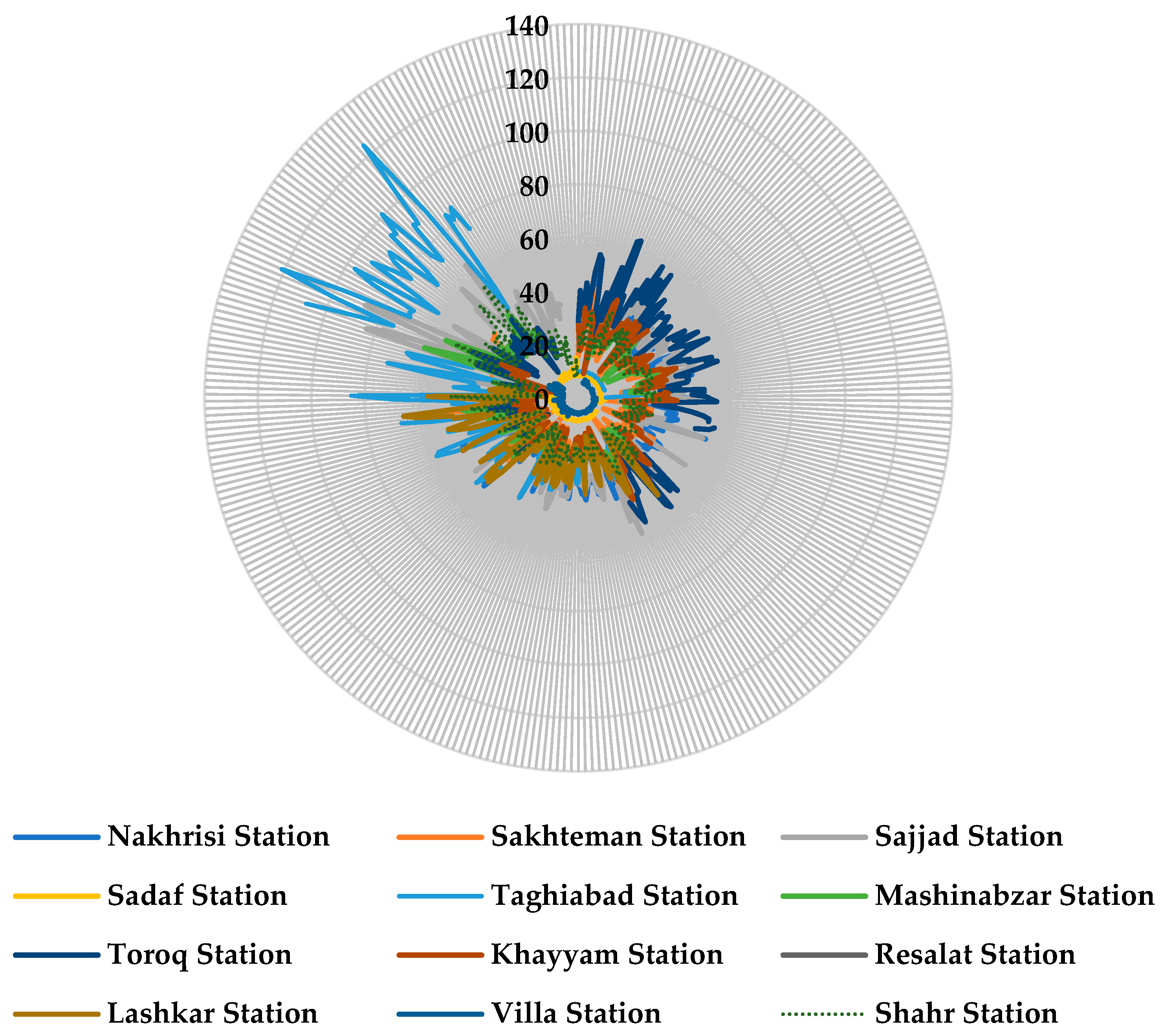
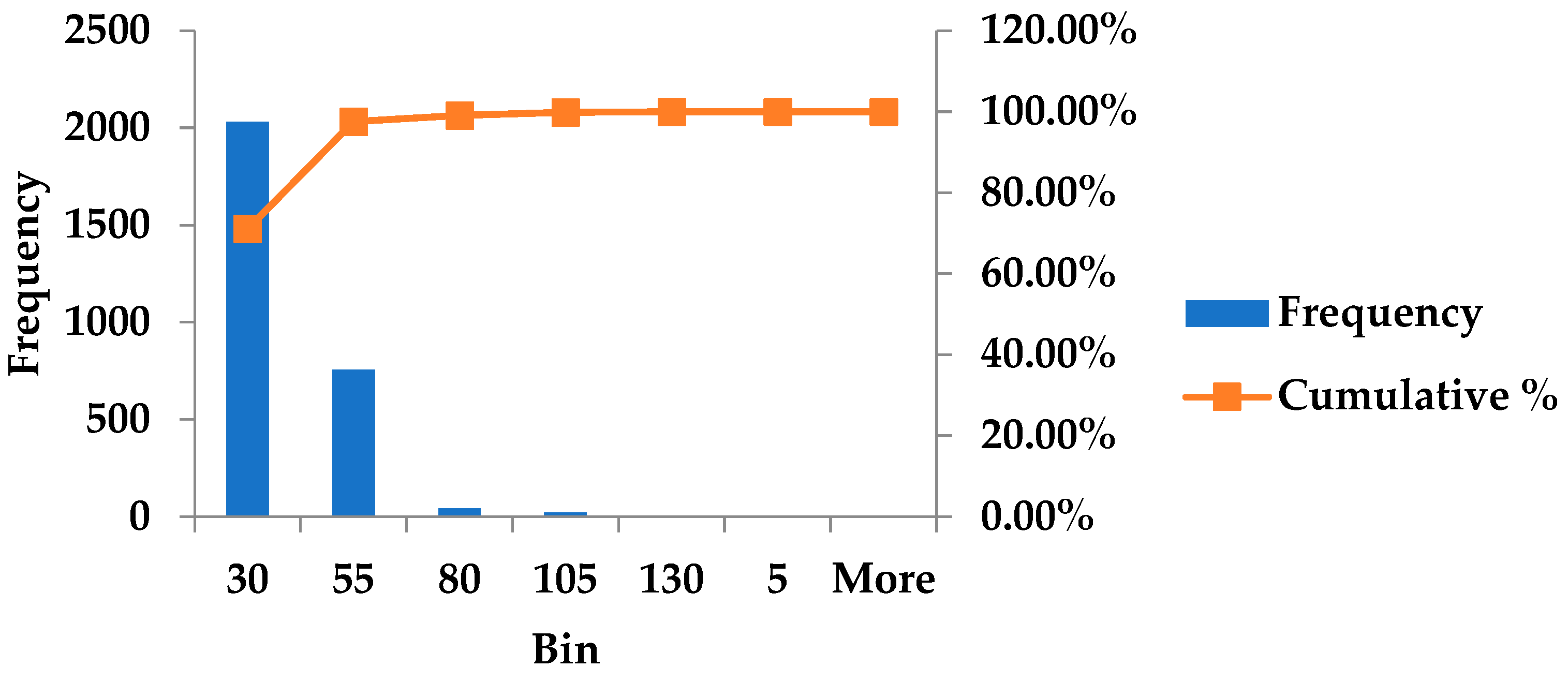
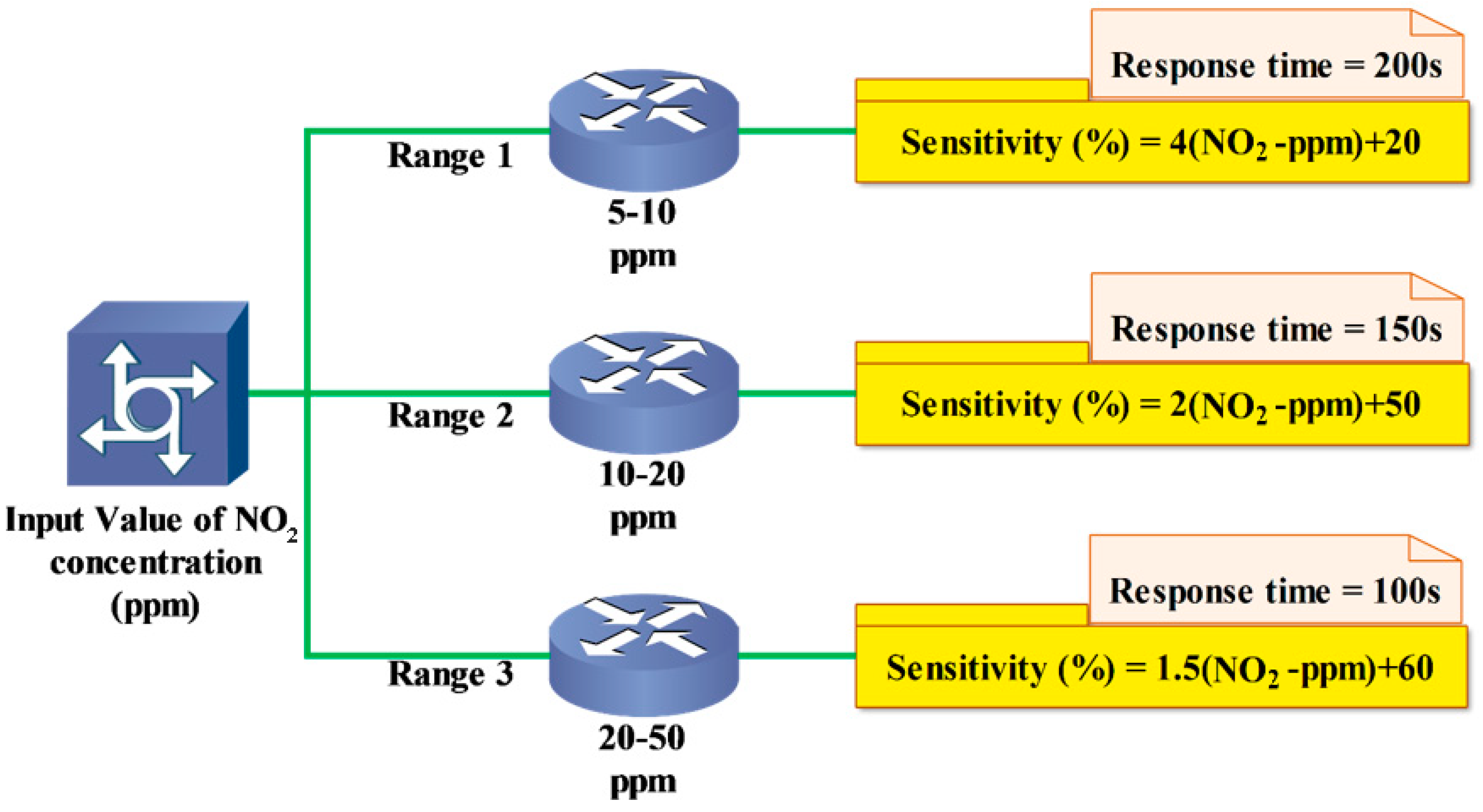
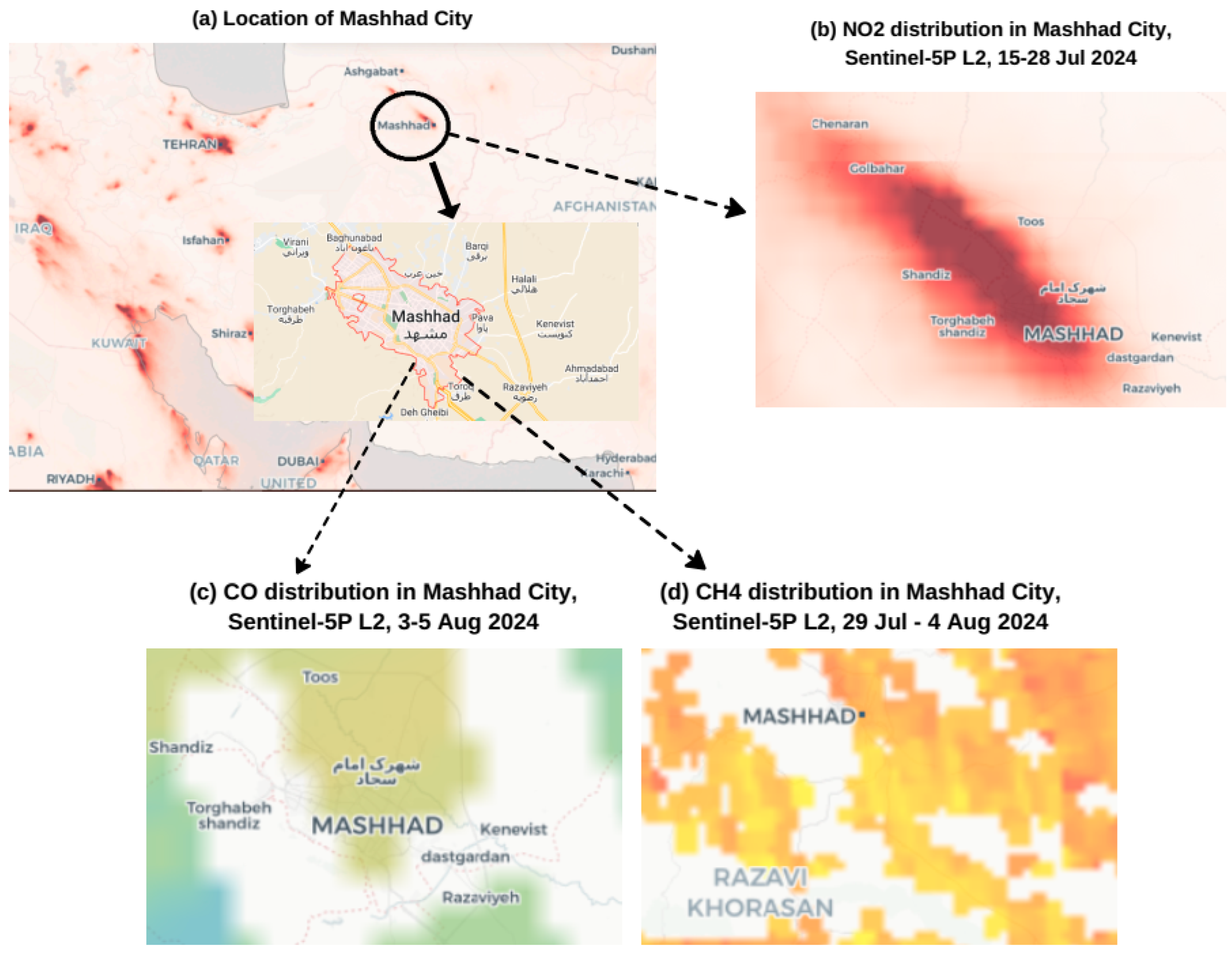
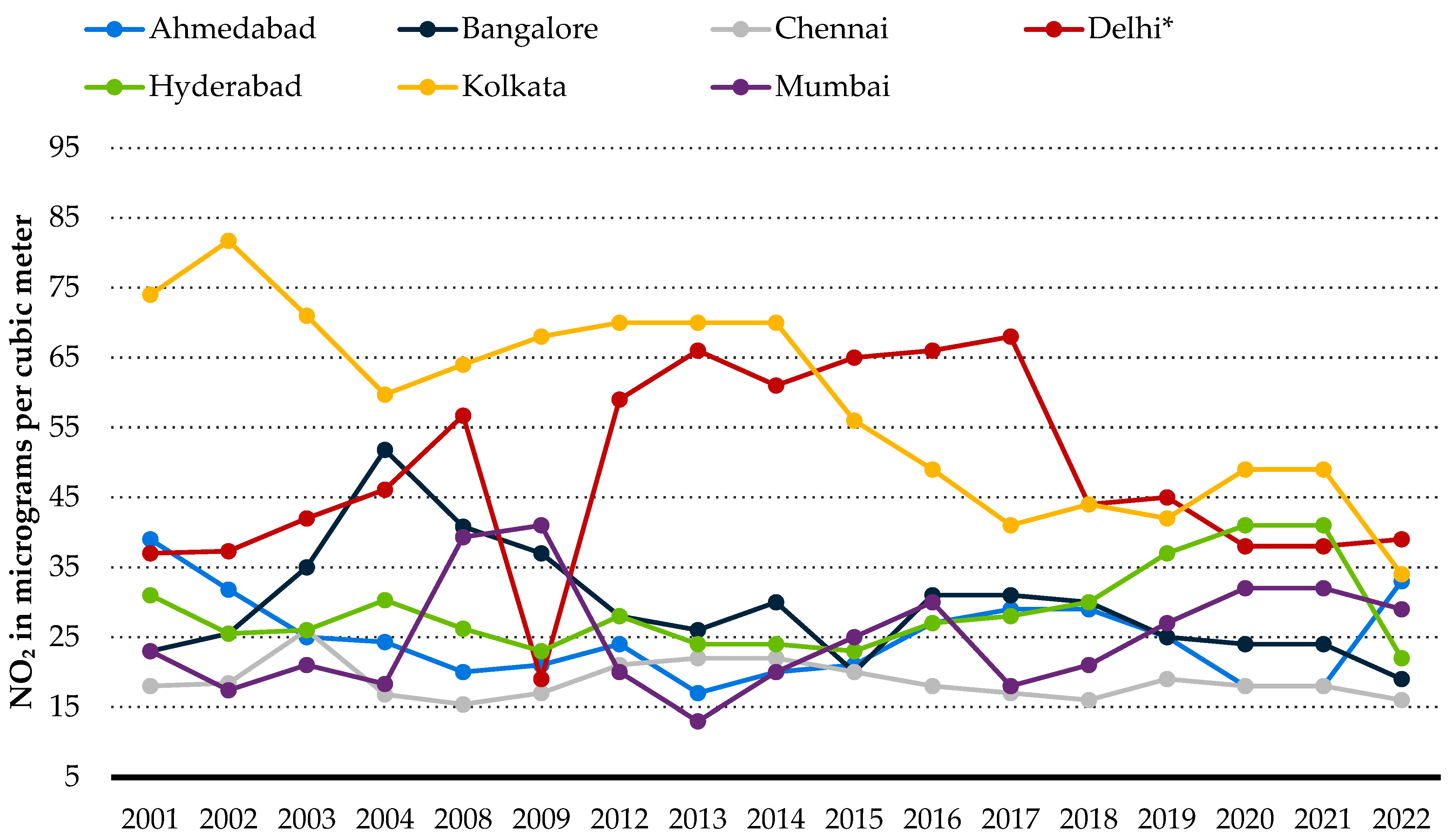

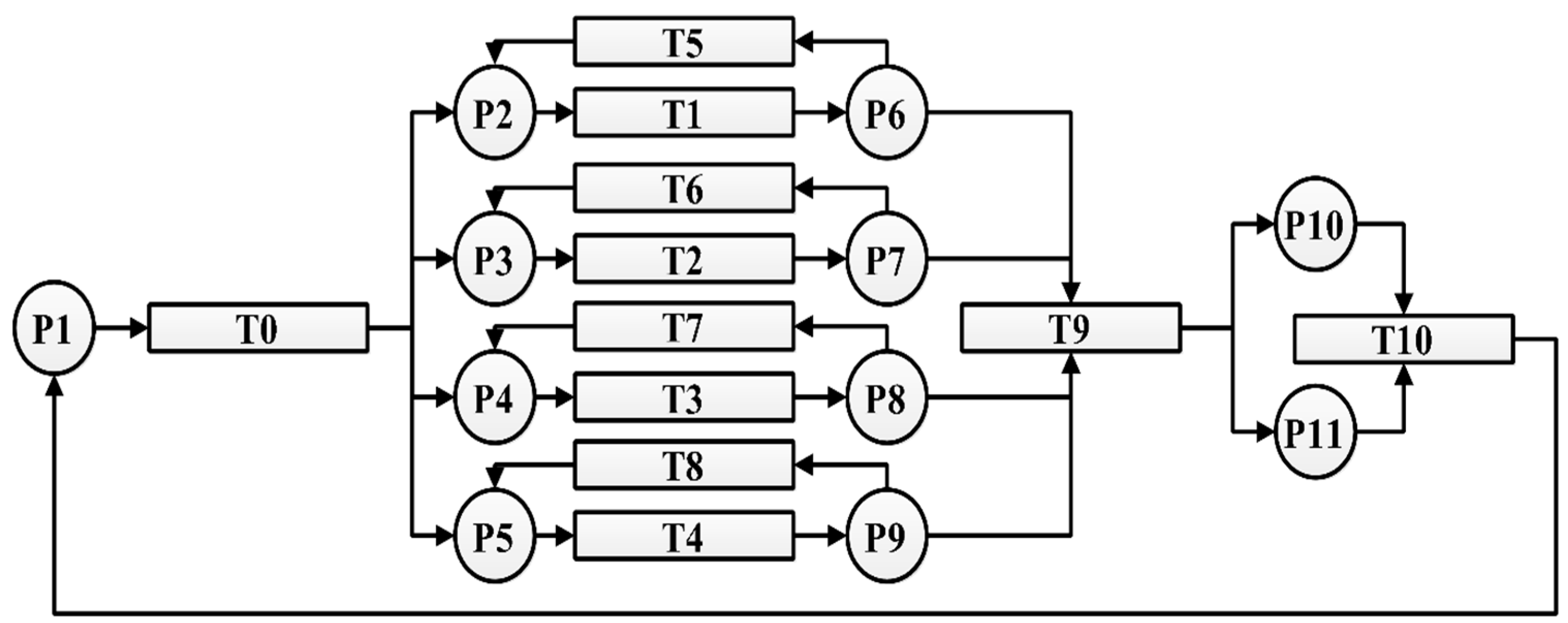
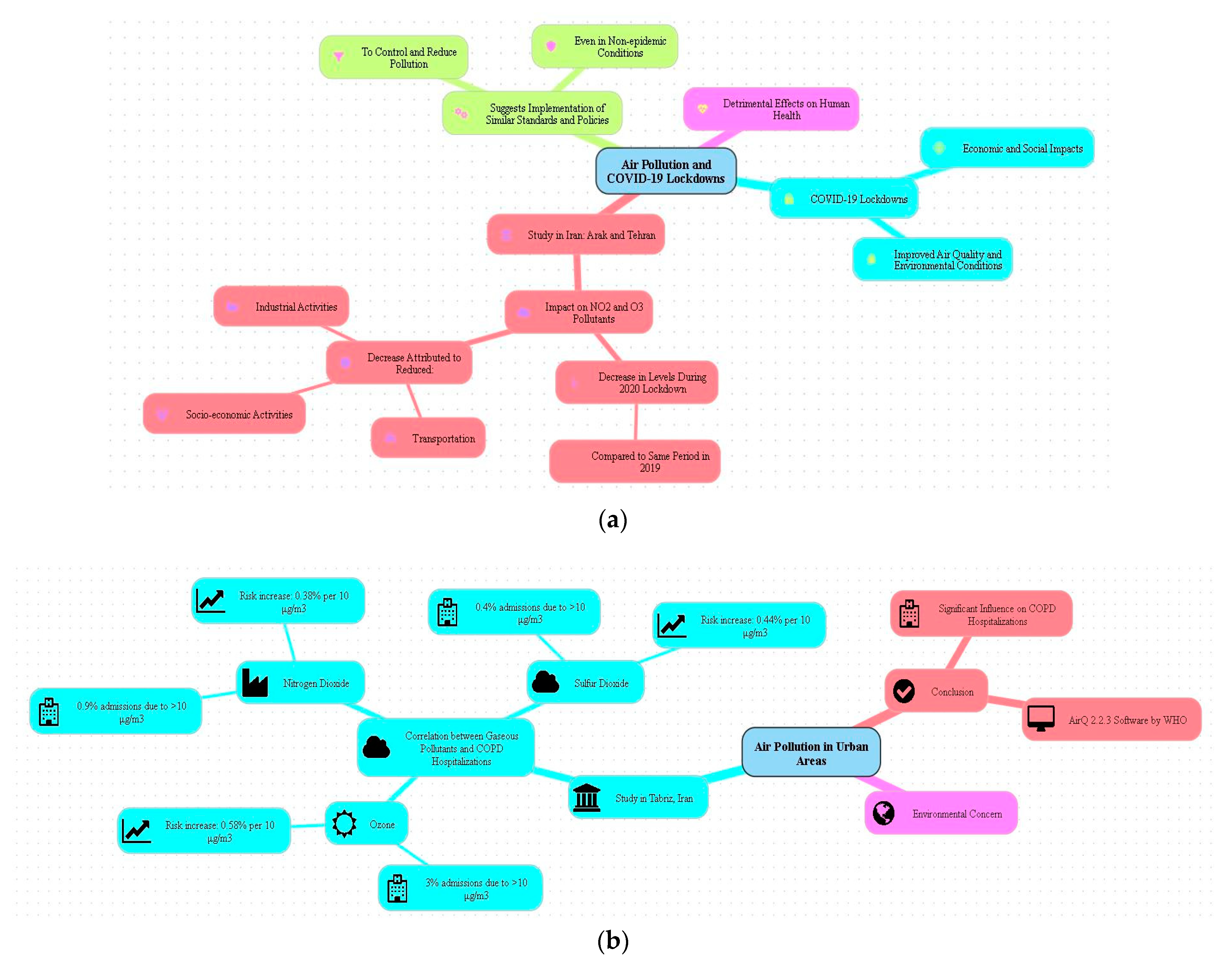
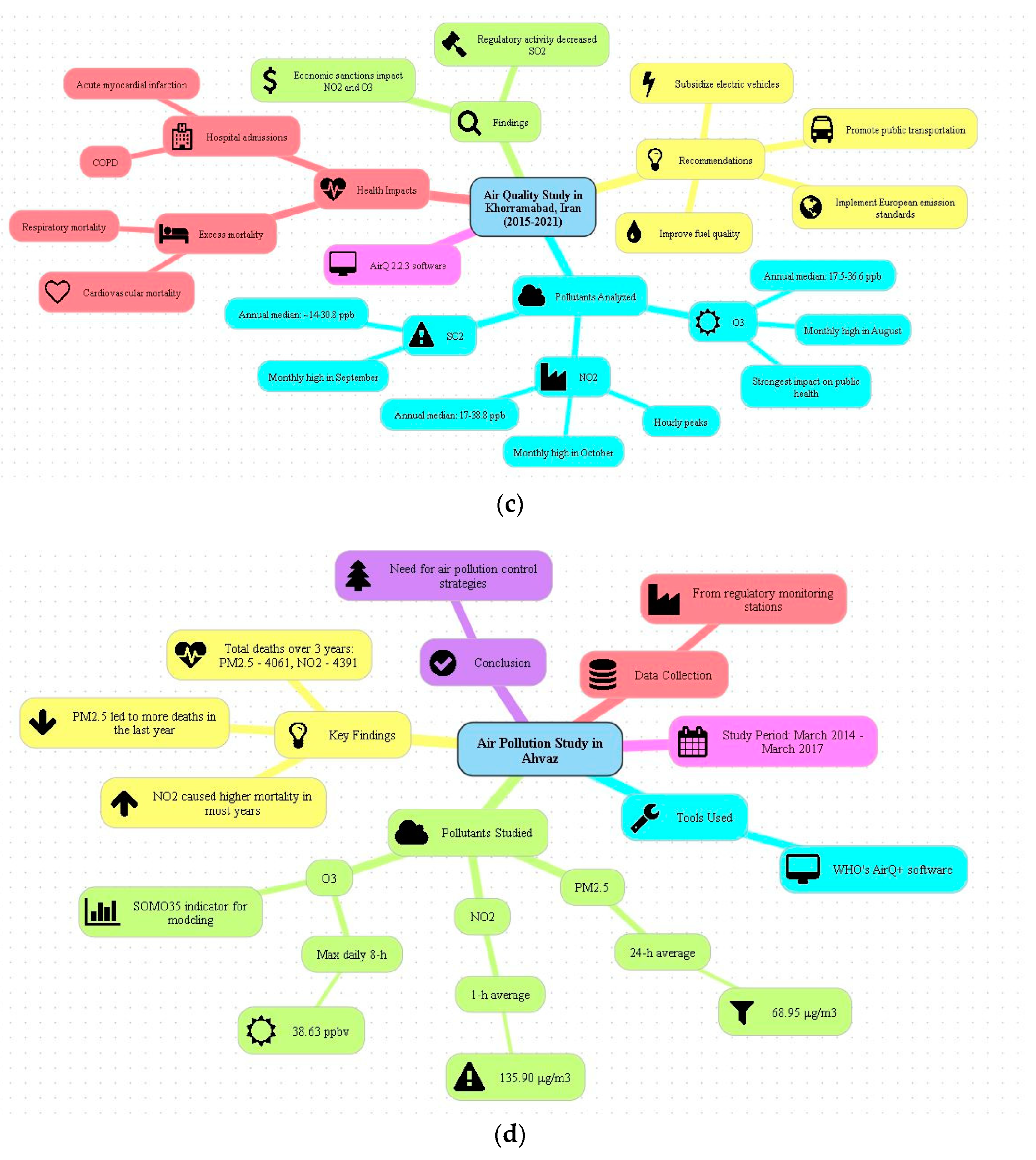
| Nr | Methodology | Application | Results | Reference |
|---|---|---|---|---|
| 1 | LoRa-based sensor network, commercial gas sensor, graphene chemoresistive sensors | Air quality monitoring and gas leakage detection | Low-cost, low-power, real-time monitoring; suitable for wireless air quality monitoring | [21] |
| 2 | Covalent Organic Frameworks (COFs), para-functionalized amine modulators | Gas separation and sensing | Enhanced gas selectivity for CO2/N2 separation under flue gas conditions | [22] |
| 3 | Sensor system, low-cost air quality gas sensors, particulate matter sensors | Urban air quality monitoring | High correlation with reference instrumentation; potential for high spatial–temporal resolution | [23] |
| 4 | IoT sensors, machine learning techniques, neural network (NN), long short-term memory (LSTM) models | Indoor air quality monitoring and prediction | High accuracy in classification and prediction of 8 pollutants | [24] |
| 5 | Wireless sensor networks (WSNs), deep learning-based approach | Air quality index (AQI) predictions | Achieved maximum accuracy of 95% | [25] |
| 6 | Custom-made low-cost air quality sensor (LAQS), adaptive neuro-fuzzy inference system (ANFIS) | Air quality sensor calibration and performance evaluation | Promising sensor accuracy improvement through ANFIS model | [26] |
| 7 | IoT-based air pollution surveillance system (APSS), regression and classification algorithms | Urban and industrial air quality monitoring | Real-time monitoring and alerts, effective forecasting and categorization of air quality | [27] |
| 8 | Smart helmet, sensors for hazardous gases and temperature, IR sensor for helmet removal | Mining industry safety | Enhanced safety measures through hazardous event detection | [28] |
| 9 | SentinAir system, CO2, NO2, and O3 sensors | Personal exposure monitoring to pollutant gases | Promising results for real-world scenarios | [29] |
| 10 | Hardware and software solution, low-cost deployable air quality monitoring device | Real-time environmental data acquisition | Effective in obtaining real-time data, potential for environmental mapping | [30] |
| 11 | Dr-TAPM, drone-based air pollution monitoring, hybrid model for data assessment | Real-time air pollution monitoring | High accuracy in predicting air quality index (AQI) data | [31] |
| 12 | Indium gallium zinc oxide (IGZO) thin-film transistor-based NO2 sensing system | Wireless NO2 detection | Excellent sensitivity and low detection limit for NO2 | [32] |
| 13 | Chemiresistor NOx gas sensors, conductive copolymer and zinc oxide blend | NOx gas sensing | Proposed a neural network for classifying sensor responses to gas concentration variations | [33] |
| 14 | Standalone smart device, hollow polyhedral ZnO, photoluminescence-enhanced Li-Fi | Remote air pollutant tracking | Enhanced sensor selectivity and sensitivity to NO2, novel telecommunication technique | [34] |
| 15 | SWCNT-based conductive sensors, gold and TiO2 nanoparticles | Room-temperature NO2 sensing | Enhanced sensitivity and reduced response time to NO2 | [35] |
| 16 | Carbon nanotube network, UV irradiation | NO2 gas sensing | Enhanced sensitivity to lower concentrations of NO2, reduced DC resistance drift | [36] |
| 17 | Wireless sensor network, mobile references, stochastic gradients | Urban air quality monitoring | Achieved long-term reliable measurements with low absolute errors for CO, NO2, and O3 | [37] |
| 18 | SnO2 nanowire network, vapor phase growth method, fluorine-doped tin oxide (FTO) electrode | NO2 gas sensing | Improved sensitivity at low temperatures and concentrations, characterized via SEM and XRD analysis | [38] |
| 19 | CuS quantum dots/Bi2S3 nanosheets, artificial neuron networks | Real-time rapid detection of toxic gases | High-sensitivity NO2 sensing, excellent responsiveness and recovery rate, low detection limit | [39] |
| 20 | Ventilation system, nitrogen monoxide/dioxide sensors, electric/hybrid trains | Air pollution control at Birmingham New Street railway station | Proposed interventions to address air pollution problem | [40] |
| 21 | Fuzzy logic, simulated annealing (SA), particle swarm optimization (PSO) | Air quality index predictions, multisensor devices | PSO performed best; identified sensitive inputs for predicting NO2 and CO concentrations | [41] |
Disclaimer/Publisher’s Note: The statements, opinions and data contained in all publications are solely those of the individual author(s) and contributor(s) and not of MDPI and/or the editor(s). MDPI and/or the editor(s) disclaim responsibility for any injury to people or property resulting from any ideas, methods, instructions or products referred to in the content. |
© 2024 by the authors. Licensee MDPI, Basel, Switzerland. This article is an open access article distributed under the terms and conditions of the Creative Commons Attribution (CC BY) license (https://creativecommons.org/licenses/by/4.0/).
Share and Cite
Gheibi, M.; Moezzi, R. Statistical Evaluation of NO2 Emissions in Mashhad City Using Cisco Network Model. Gases 2024, 4, 273-294. https://doi.org/10.3390/gases4030016
Gheibi M, Moezzi R. Statistical Evaluation of NO2 Emissions in Mashhad City Using Cisco Network Model. Gases. 2024; 4(3):273-294. https://doi.org/10.3390/gases4030016
Chicago/Turabian StyleGheibi, Mohammad, and Reza Moezzi. 2024. "Statistical Evaluation of NO2 Emissions in Mashhad City Using Cisco Network Model" Gases 4, no. 3: 273-294. https://doi.org/10.3390/gases4030016
APA StyleGheibi, M., & Moezzi, R. (2024). Statistical Evaluation of NO2 Emissions in Mashhad City Using Cisco Network Model. Gases, 4(3), 273-294. https://doi.org/10.3390/gases4030016







